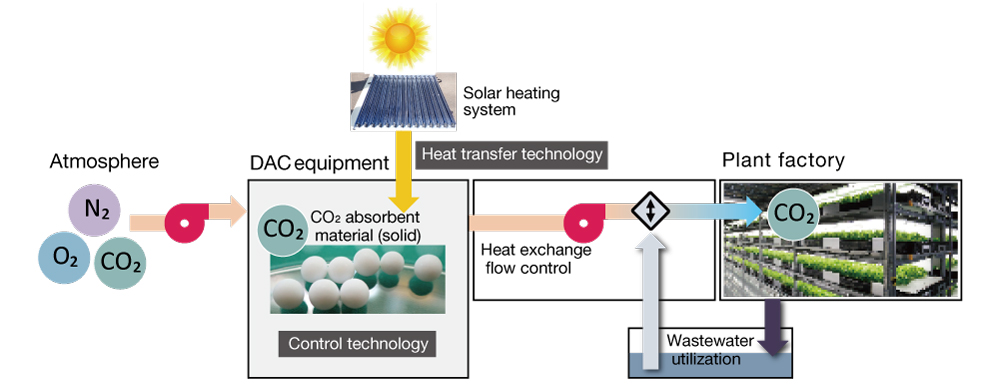Ushio participates in Tokyo Metropolitan University’s Direct Air Capture (DAC) R&D together with Taikisha Ltd.
Ushio Inc. (Head office: Tokyo, President and CEO: Koji Naito, hereinafter “Ushio”) is pleased to announce that it is taking part in the joint R&D initiative led by Tokyo Metropolitan University (President: Takaya Ohashi, hereinafter “TMU”) on direct air capture (hereinafter “DAC”), together with Taikisha Ltd. (Head Office: Tokyo, Representative Director and CEO: Masashi Osada, hereinafter “Taikisha”). The initiative started the development of DAC equipment that can capture carbon dioxide (CO2) from the atmosphere for the use in plant factories, etc.
As pointed out by the IPCC*1, one factor contributing to climate change is the increasing CO2 concentration in the atmosphere caused by digging up carbon, such as coal, petroleum, and natural gas, from underground. While the development of social infrastructure and technologies that do not rely on carbon from underground progresses toward carbon neutrality by 2050, DAC technology that directly captures CO2 from the atmosphere and utilizes it is proposed to completely reduce CO2 emissions to zero. However, the technology has still room for improvement in efficiency and cost and requires highly efficient materials and systems in order to capture low-concentration CO2 (400 ppm) from the atmosphere.
Against this backdrop, the research group led by Professor Seiji Yamazoe at the Department of Chemistry of the Graduate School of Science, TMU, has identified isophoronediamine as an ideal material for DAC due to its extremely high CO2 absorption property that greatly surpasses existing technologies*2.
In an effort to put TMU’s DAC into practical use, Ushio will work on the development of DAC equipment by utilizing its absorbent material that helps improve the efficiency of CO2 absorption as well as the Company’s light and heat collection technology that realizes energy-saving CO2 desorption, and by combining them with Taikisha’s high efficiency gas circulation and heat exchange system.
The CO2 thus captured will be available for use in plant factories and for greenhouse cultivation, to accelerate the growth of crops and factory-grown algae, etc., and for synthesizing fuels and chemicals.
Ushio, TMU, and Taikisha have named the CO2 in the atmosphere SkyCarbon® and launched the SkyCarbon Initiative that utilizes the SkyCarbon for carbon offset. As part of the effort, Ushio will first introduce DAC equipment to the plant factories owned by the Taikisha Group (Figure 1) and start R&D and demonstration experiments in order to realize a carbon circulation society which enables taking not only climate change but also food measures and making people’s life richer with the aim of commercialization of DAC by 2030.

Figure 1: DAC equipment introduced in a plant factory
The DAC equipment consists of a CO2 absorbent material that only absorbs CO2 in the atmosphere, a heat source (utilizing sunlight) necessary to capture the absorbed CO2, a heat transfer technology that transfers heat to the CO2 absorbent material, and a control technology. The sunlight is efficiently converted into heat to electrically heat Ushio’s unique CO2 absorbent material made of solidified isophoronediamine using Ushio’s cylindrical solar collector under development and captures CO2 with low energy. Wastewater from the plant factory is utilized to reduce the heated gas temperature of the captured CO2 supplied to the plant factory.

Figure 2: SkyCarbon Initiative conceptual illustration
The SkyCarbon Initiative captures CO2 in the atmosphere and transforms it into familiar and useful substances, thus contributing to carbon neutrality and negativity in the atmosphere.
In order to achieve the goal of becoming a “light” solutions company set in the Vision 2030, Ushio will also contribute to global warming prevention by realizing a world where global carbon net zero emissions and the wellbeing of people are in harmony with each other through social implementation of DAC.
*1 Abbreviation of Intergovernmental Panel on Climate Change, an intergovernmental organization established in 1988 by the World Meteorological Organization (WMO) and United Nations Environment Programme (UNEP).
*2 S. Kikkawa, K. Amamoto, Y. Fujiki, J. Hirayama, G. Kato, H. Miura, T. Shishido, S. Yamazoe
Direct Air Capture of CO2 Using a Liquid Amine-Solid Carbamic Acid Phase-Separation System Using Diamines Bearing an Aminocyclohexyl Group, ACS Environ. Au, 2, 354-362 (2022).
